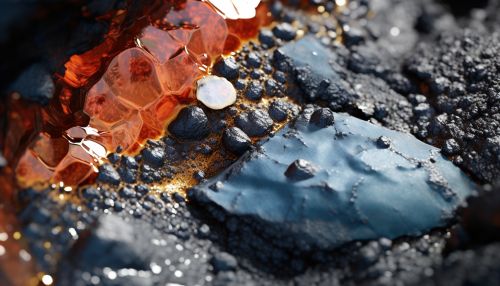Bioleaching
Introduction
Bioleaching, also known as biomining, is a biotechnology process that uses microorganisms to extract metals from ores and concentrates. This process is primarily used to extract metals from low-grade ores that are not economically viable to process through traditional mining methods. Bioleaching is a sustainable method of metal extraction that reduces the environmental impact of mining operations, as it does not require the use of harmful chemicals or high energy inputs.
History
The use of microorganisms in metal extraction has been known for centuries, with the earliest recorded use dating back to the Roman Empire. However, it was not until the 20th century that the scientific community began to understand the mechanisms behind this process. In the 1950s, scientists discovered that certain bacteria, such as A. ferrooxidans, were capable of oxidizing iron and sulfur in low-grade ores, thereby facilitating the extraction of valuable metals. This discovery led to the development of the modern bioleaching industry, which has since expanded to include a variety of different microorganisms and extraction methods.


Microorganisms Involved
The process of bioleaching relies on the metabolic activities of certain microorganisms that are capable of oxidizing metal sulfides. These microorganisms, which include bacteria, archaea, and fungi, are typically acidophilic, meaning they thrive in acidic environments. The most commonly used microorganisms in bioleaching are bacteria from the genera Acidithiobacillus, Leptospirillum, and Sulfobacillus. These bacteria are capable of oxidizing iron and sulfur, which are common components of metal ores.
Process
Bioleaching can be carried out in several ways, depending on the type of ore and the specific microorganisms being used. The most common method is heap leaching, where the ore is crushed and piled into a heap. The heap is then irrigated with a solution containing the bioleaching microorganisms, which begin to oxidize the metal sulfides in the ore. This oxidation process produces sulfuric acid, which then leaches out the metal ions from the ore. The metal ions are then collected from the leachate and processed to extract the pure metal.
Applications
Bioleaching has a wide range of applications in the mining industry. It is primarily used to extract copper, gold, and uranium from low-grade ores. However, it can also be used to extract other metals such as nickel, zinc, and cobalt. Bioleaching is particularly useful for extracting metals from ores that are difficult to process using traditional methods, such as refractory gold ores. In addition to metal extraction, bioleaching can also be used for the remediation of contaminated soils and waste materials.
Advantages and Disadvantages
Bioleaching offers several advantages over traditional mining methods. It is a more sustainable method of metal extraction, as it does not require the use of harmful chemicals or high energy inputs. Bioleaching also allows for the extraction of metals from low-grade ores that would otherwise be considered waste. However, bioleaching also has some disadvantages. The process is typically slower than traditional mining methods, and the yield of metal is often lower. Additionally, the process produces sulfuric acid, which can cause environmental damage if not properly managed.
Future Prospects
The future of bioleaching looks promising, with ongoing research aimed at improving the efficiency and effectiveness of the process. Advances in genetic engineering and synthetic biology could potentially lead to the development of new strains of microorganisms that are more efficient at extracting metals from ores. Additionally, new bioleaching methods are being developed that could potentially reduce the environmental impact of the process.
